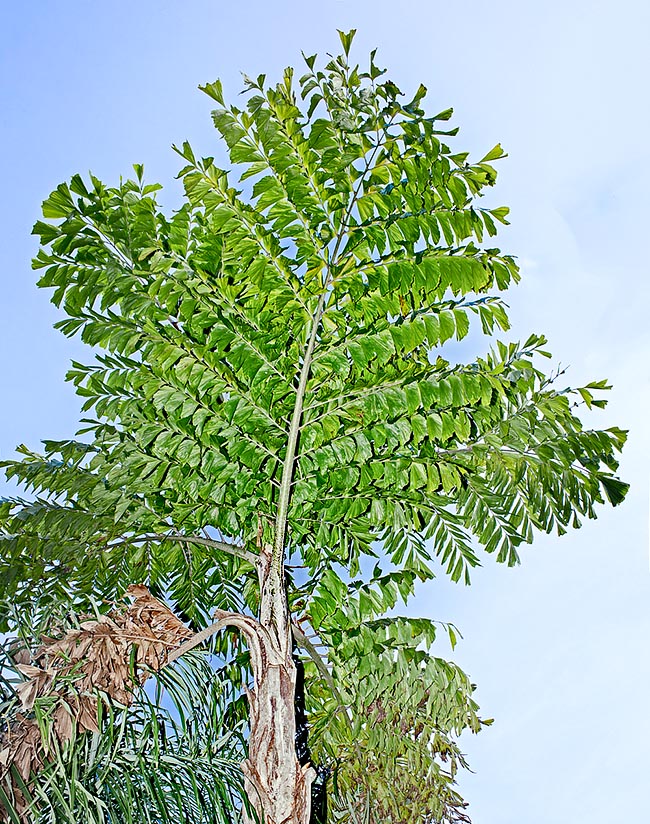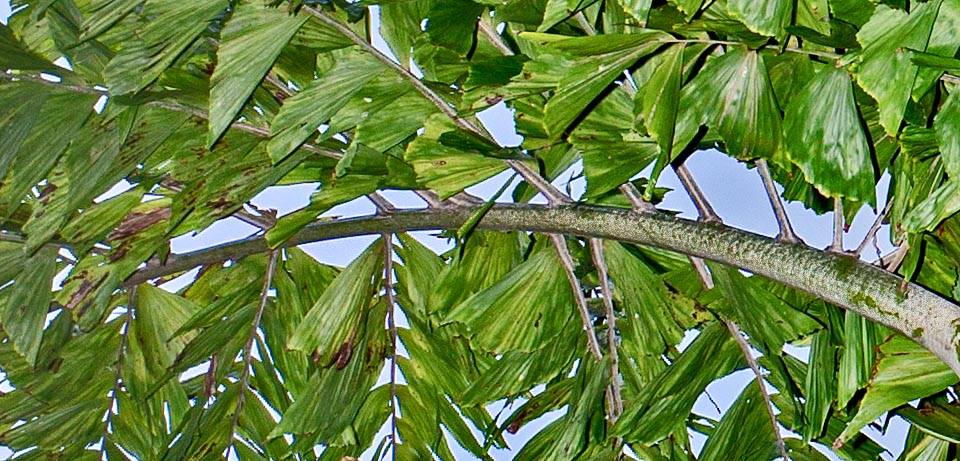Family : Arecaceae

Text © Pietro Puccio

English translation by Mario Beltramini

Native to Vanuatu, the Caryota ophiopellis reaches the height of 6-9 m with 30-40 cm of diameter © Giuseppe Mazza
The species is native to Vanuatu (Tanna and Anatom islands) where it grows in the underwood of the humid forests, mainly along the coasts, pushing inside up to about 400 m of altitude.
The name of the genus is the Latin substantive of Greek derivation “caryota, ae” = date, fruit of the palm; the specific name is the combination of the Greek substantive “ὄφις” = snake and of the Latin substantive “pellis, is” = skin, with reference to the dark bands present on the foliar base, petiole and rachis that recall a snake’s skin.
Common names: snakeskin fishtail palm, snake-skin palm (English); palmier serpent, sagoutier (French); nip, nipitari, inrejei (Vanuatu).
The Caryota ophiopellis Dowe (1996) is a monoecious, monocarpic species (it does fructify only once then dies), with solitary stem, 6-9 m tall and of 30-40 cm of diameter, of greyish colour on which are evident the foliar scars of the fallen leaves, spaced of 20-30 cm.
The leaves, on an about 60 cm long petiole, are bipinnate, up to about 3 m long, with coriaceous leaflets, of glossy intense green colour above, obliquely cuneiform with toothed-crenate apex and arranged regularly on the lateral pinnae.
Petiole, lower part of the rachis and upper part of the foliar base are covered by whitish tomentum with irregular dark transversal lines, that simulate, as the author cites, the skin of the Candoia bibroni Duméril & Bibron, 1844, a local snake.
Inflorescences between the leaves, about 1 m long, with ramifications of the second order, an exception for the genus (of first order in the other species), bearing unisexual flowers arranged in triads (one female flower between two male); the male flowers ripe before the female ones (proterandry) favouring the crossed fecundation. The flowering goes from the apex to the bottom (basipetal), once completed the ripening of the fruits of the lowest inflorescence the plant dies.
Globose fruits black when ripe, of about 2 cm of diameter, usually containing one black globose seed, of 1-1,5 cm of diameter, rarely two.

The petioles, with dark lines, recall a snake’s skin. The stem is rich of edible starch. Rare in cultivation, might have, also in inner spaces, a horicultural future © G. Mazza
It reproduces by seed, previously kept in water for two days, placed in draining organic loam maintained constantly humid at the temperature of 26-28 °C, with germination times of about three months.
Quite rare in cultivation, it arouses an increasing interest due to the unusual and showy colouration of the petioles, in particular in the young plants. It requires a tropical or humid subtropical climate, not bearing temperatures close to 0 °C, even if short lasting, a shady position during the young stage, slightly shaded when adult, and draining soils, slightly acidic to neutral, maintained humid. The young plants are potentially an interesting subject as plant in pot for the decoration of inner spaces. The starch contained in the stem, extracted with a special procedure and cooked to prepare a sort of bread, is still now utilized by the local populations during the famine periods.
→ For general notions about ARECACEAE please click here.
